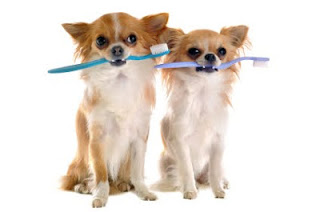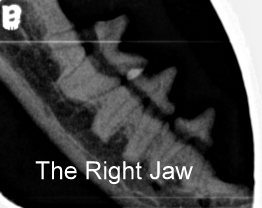As a vet who performs dentistry procedures on our pets on a daily basis, I can't remember the last time that I was faced with one that was predictable or routine. There is usually something - it can be minor, but I can't recall the last pet where it was "just a clean".
 |
As a pet owner, I certainly understand the desire for knowing exactly how much something is going to cost before it is done. I definitely understand wanting some kind of control of what is happening to my beloved pet.
Whenever you put your pet in the hands of your vet, there is an enormous trust placed in our (vet) hands.
As a human, at my dentists appointment, it has been my experience that the dentist will sit there and spend a good 10 to 15 minutes probing my teeth, whilst I am lying there "calmly" so that they can collect all the information.
Sadly, our animals aren't going to sit there and go "AAAH".
It has been my experience with the human dental side that they will perform full mouth dental radio graphs to identify any hidden pathology, or refer me to a facility that does. They may ask me to "bite down" on the bitewings so they can take good xrays, or they may ask me to stand still for 5 minutes biting down on something whilst something whizzes around my head taking a full mouth xray picture.
On the human side, once they have that information, they are then able to give a more accurate assessment of what needs to be done, and how much it is going to cost.
Now, let us go to our animals. I have yet to meet an animal that is going to allow me to place a periodontal probe around each of their 42 (if dog) or 30 (if cat) teeth. They are not going to stay super still whilst I place my (expensive) dental film, and then try to position the xray beam in the right angle, to get the diagnostic films I need to get.
Dental examinations on pets whilst they are awake is a great start, but the true assessment starts when they are dreaming of chasing rabbits (or mice if they are cat), so we can do what us vets can do what we do best - to diagnose (and then treat) disease.
 |
| With a pet under anaesthetic we can then check each tooth properly. |
 |
| This is a dog's dental chart - we document the information on each and every tooth |
 |
| Whilst the perio probe isn't sharp, its not comfortable, especially in a mouth with red gums and pain. |
Sadly, we miss so much disease on just visual examination alone - there are so many times that we miss things until we start doing a more thorough, collected assessment.
The problem lies in that the pet owner (rightly) wants an estimate of the procedure before hand, and (sadly) when it comes to dental work that is impossible. Well, it can be done - we could give the pet two anaesthetics - the first to collate the information, and then a second one a week or so later to perform the dental work.
In fact, isn't that what the human dentists do? Ask us to go back to perform dental work in stages?
 |
| This is Pusski, not Putty Cat but they could be twins! |
Putty Cat's story is a classic example of "you miss more for not looking than not knowing", or how a "routine dental" ended up as something totally different.
Putty Cat is only 8 years old, and he is happy and healthy, who rules the house with his typical subtle but firm, cat style! He had only recently moved to Woonona.
When he came in for his first dental check, there was alot of brown stuff sticking onto his back teeth digging into his gums - tartar in this area is typical of animals who are choosing not to chew their food, and frankly, that is not normal!
He came in for his "dental", and on charting he was found to be missing a tooth on his left lower side. On probing, there was a small hole in his gum, so we went on to radiograph this area.
I will let the radiographs below tell the rest of the story.
 |
| I put a needle in the area where the sinus was - |
 |
| It always helps to know what "normal" is - so we now play the game of "Spot the difference" |
 | |
| Do you see the tooth root? |
 |
| Now you can see where it has been! |
- any tartar on the teeth can be the signal that something is not normal
- full probing and examination of the teeth with the benefit of some drugs is needed
- dental xrays are always needed to identify the hidden disease (like Putty Cat)
- There would've been no way to predict the tooth abscess, or the retained tooth root fragment on a conscious dental examination, and no way to give an estimate for that prior.
I am Dr Liz, the mad vet from Bellambi.
Dental checks at Russell Vale Animal Clinic are FREE all year round, so take advantage of a weigh in, a happy visit filled with treats for your pet, and advice on how to keep your pet's teeth healthy.


